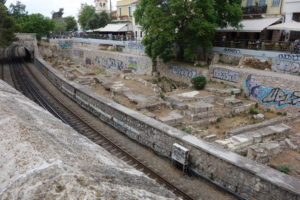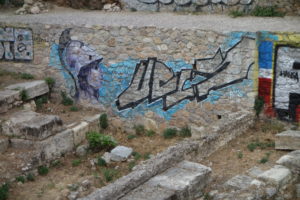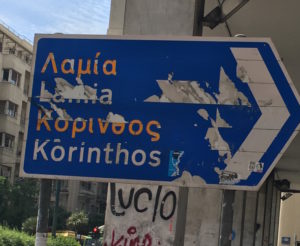
Photo courtesy of Jean West
Graffiti on the Metro
The endless flight was finally over, the Metro ride coming to an end, but my education about graffiti just beginning. As we came into the Monasteraki Square Station I saw colorful artwork on the side of another train.
As it passed, I noticed more graffiti on the wall behind the tracks, supposedly protecting some ruins from foot traffic. At first I was impressed with the artwork, but then it felt like sacrilege. Athens was a special place, with many thousands of years of history. Why would anyone insult it in such a way?
The warm Mediterranean air caressed my face as I descended from my Metro car, pushing a roller bag ahead of me as I carefully minded the gap. Stepping down, I took a deep breath, then coughed, my throat overwhelmed by the smell of city air and spices.
Graffiti in the City
Two columns on the platform were also covered in graffiti, as was a baggage cart piled high with suitcases and backpacks. It clattered away from us over the uneven concrete and stones, baring the underside of the city of my dreams.
I was shocked. This was the Athens of gods and goddesses, the home of myth and ancient history. As we walked around the city over the next three days, I gradually realized that the graffiti was everywhere. It troubled me.

Photo courtesy of Jean West
And then I looked up “Athens Graffiti Art” on the internet, where Matt Barrett reminded me that in ancient times graffiti was carved into buildings. In fact, he said, the word comes from the Greek graphi, which means to write.
During the Nazi occupation, I learned, the Civil War and the 1967 Junta, political graffiti was common in Athens, generally for political reasons. To quote Barrett, “Nowadays it is mostly the work of frustrated kids whose signatures all over the city seem like a cry for help to a world that does not notice that they exist.”
Another author explained modern graffiti as reflecting “the hardships and unemployment of the Greek economic collapse.” 
Symbols of Hardship and Unemployment
Well, of course, I thought. This is not only the Athens of Ancient Greece, it is also the Athens of the modern world, the Athens of discord, of poverty, of government and EU disagreement, of unemployment and disharmony.
It is also, I remind myself, the Athens of the Greece who is taking in refugees by the thousands, sheltering them, feeding, them and giving them hope. It may not be the Athens of my dreams, but it is what it is, and the graffiti may well be suited to the era that has spawned it.
In the two weeks that have passed since those machinations, I have met many Greek people. Some described themselves as natives; others as immigrants. I have talked with bus drivers, restaurant owners, proprietors of jewelry stores and mini-marts. Taxi drivers, hotel workers, farmers and orchardists and teachers. Most of them are angry with Athens, because they do not feel that it represents their country any more.
When I said with a shrug, “Well, many big cities are like that” – referring to the pickpockets on the Metro we had encountered on our third day in Athens – our host at a Santorini resort staunchly disagreed.
“No!” he said. Not Rome – not Paris, nor Brussels, or London. They are not like this. They have not degraded like this. They do not treat their visitors like this. ”
“Athens,” he concluded, “needs some work.”
Share this post




